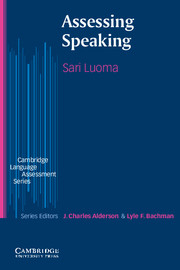7 - Developing speaking tasks
Published online by Cambridge University Press: 03 May 2010
Summary
In this chapter, I will begin with examples of speaking tasks in order to make the discussion concrete. As we saw in Chapter 6, test design starts from analysing the purpose of the test: what will the scores be used for, and what type of information do the score users need? This guides both the construct definition and the choice of tasks and criteria. If they define the purpose mainly in terms of language activities, they may decide to use different types of talk or language functions as the main design principle for the tasks. If they need information about the examinees' ability to deal with some specific speaking situations or some professional roles, they will use these as main categories in the task design. If they need information about aspects of the examinees' control of language, such as their pronunciation skills or their knowledge of certain grammar points, they may use highly structured tasks such as reading aloud or sentence completion, where they can control exactly what the examinees will say. All these types of tasks will be exemplified below.
Examples of speaking tasks
Description tasks
Here are two examples of description tasks.
Example 1: Interaction outline for a one-to-one interview
Describe to me the room or area where you work.
Example 2: Interaction outline for a pair task in an interview test
In this part of the test, I will give each of you a picture. Don't show the pictures to each other.
- Type
- Chapter
- Information
- Assessing Speaking , pp. 139 - 169Publisher: Cambridge University PressPrint publication year: 2004



